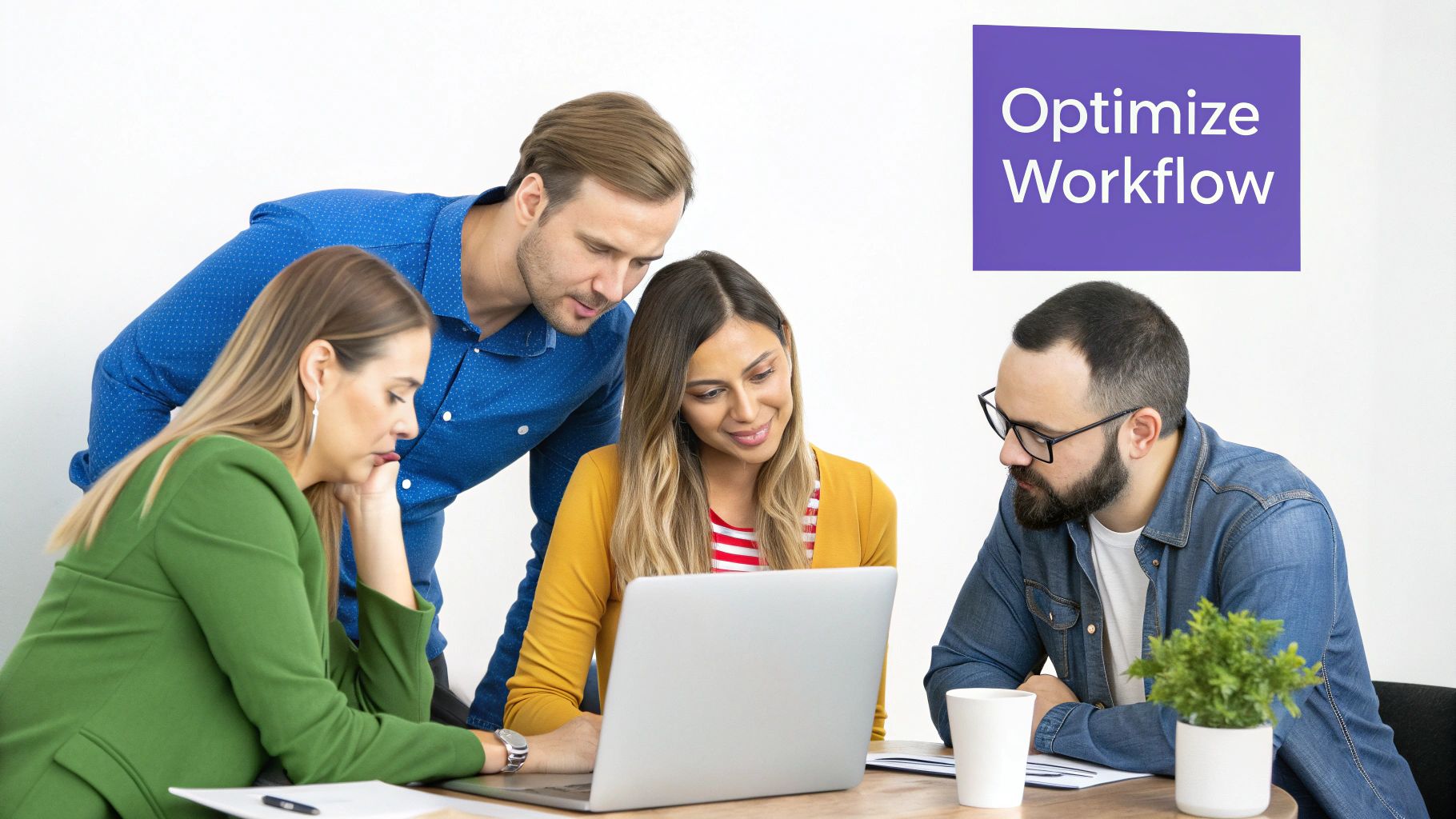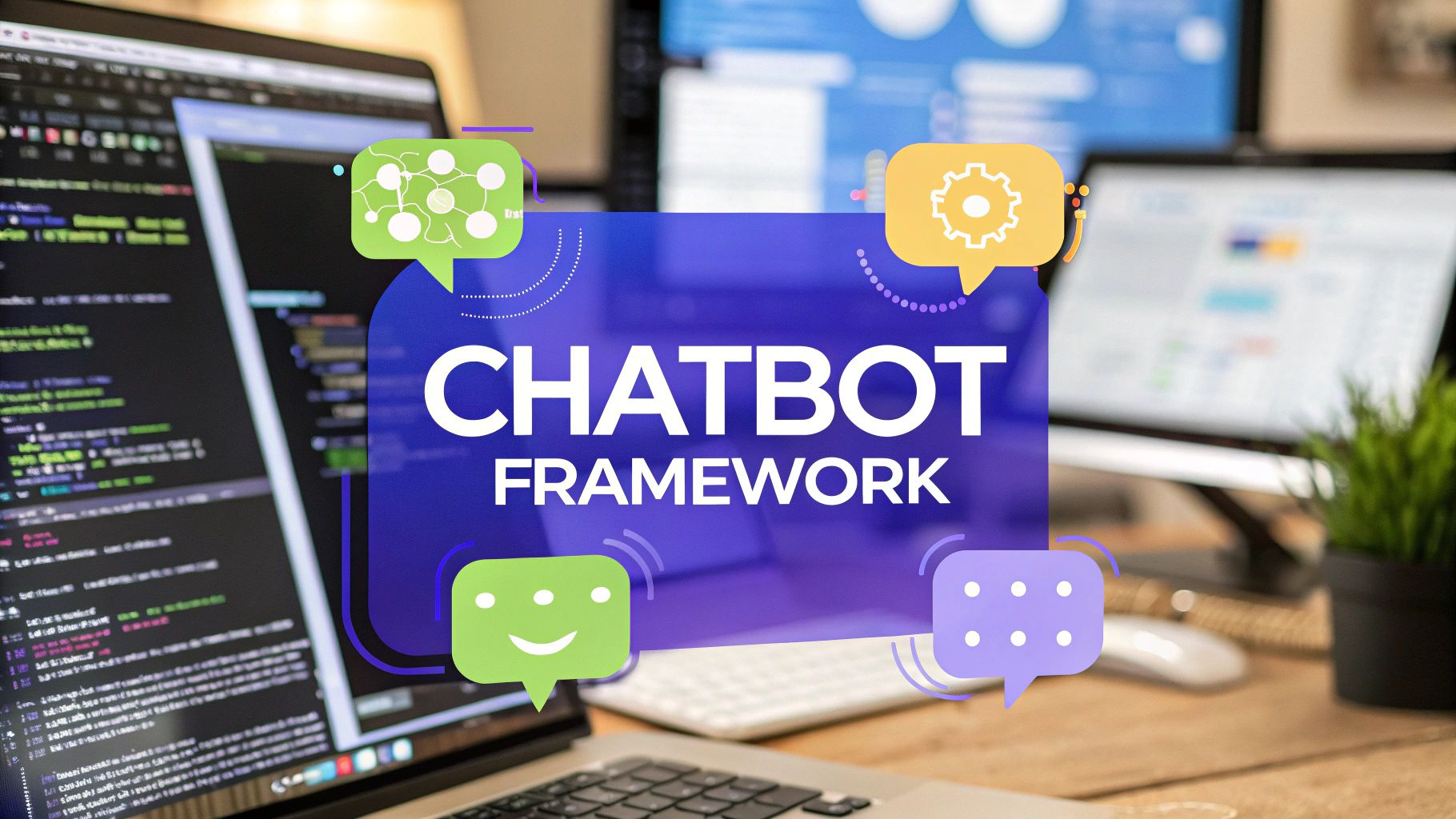A Guide to Lead Generation Chatbots
Unlock growth with our guide to lead generation chatbots. Learn how to engage visitors, qualify leads, and automate your sales funnel for measurable results.

At its core, a lead generation chatbot is an automated program designed to chat with your website visitors, capture their contact details, and figure out if they're a good fit for your sales team.
Think of it as your website's digital concierge—always on, always ready to help, and incredibly good at turning casual browsers into real, qualified prospects.
What Are Lead Generation Chatbots?

Imagine your best sales development rep. They're friendly, sharp, and know exactly which questions to ask to spot a potential customer. Now, imagine they could be on your site 24/7, greeting every single visitor instantly without ever needing a coffee break.
That’s pretty much what a lead generation chatbot does.
Unlike a static contact form that just sits there waiting for someone to fill it out, these chatbots proactively kick off the conversation. They guide users, answer questions, and steer people toward the right information, all through a natural, chat-like interface.
How Chatbots Turn Visitors into Leads
A well-designed chatbot feels helpful, not pushy. It doesn't just pop up demanding an email address. Instead, it follows a smart, engaging script that builds a little trust before asking for contact info.
This is a core principle behind learning how to automate lead generation without sacrificing the human touch. The bot uses a series of simple questions and pre-set conversation paths to qualify visitors on the spot.
For example, a chatbot on a software company's pricing page might ask things like:
- "What's your company size?"
- "What's the main thing you're hoping to achieve with our software?"
- "Would you be interested in a quick demo?"
Based on the answers, the bot can figure out if the visitor is a solid lead for the sales team. If they are, it will then ask for their contact details and can even book a meeting directly on a sales rep's calendar.
A lead generation chatbot transforms your website from a static brochure into an interactive sales machine. It automates the very top of your sales funnel, making sure no potential customer slips away unnoticed.
And the results speak for themselves. One study found that 55% of companies saw a jump in high-quality leads after adding a chatbot. In some industries, these bots achieve conversion rates as high as 70%. This makes perfect sense when you consider that 53% of buyers actually prefer to shop with businesses they can message directly.
The Core Functions
At its heart, a lead generation chatbot handles a few key tasks that used to be entirely manual. These functions work together to create a smooth handoff from the first "hello" to a fully qualified lead.
To break it down, here are the essential jobs a lead gen bot performs.
Core Functions of a Lead Generation Chatbot
These tasks combine to create a seamless pipeline, ensuring that your sales team spends their time talking to genuinely interested prospects, not chasing down cold contacts.
Putting a chatbot on your website is more than just a quick tech update—it’s a real business decision that can fundamentally change how you connect with potential customers and deliver measurable results for your sales and marketing teams.
Here’s a look at the core benefits you get when you move beyond static forms and start having real conversations.
Capture Leads 24/7
Your sales team has to sleep, but your website is always on, attracting visitors from different time zones around the clock. A chatbot acts as your always-on virtual agent, ready to engage someone the moment they land on your site.
This means you stop losing out on valuable leads who show up after hours, on weekends, or during holidays. No matter when a prospect visits, their questions get answered instantly, and their info is captured right then and there.
Qualify Leads Instantly
One of the biggest time sinks for any sales team is sifting through a mountain of inquiries to find the few who are actually ready to buy. A chatbot can handle this entire process for you.
Using smart, conditional questions, the bot can qualify visitors on the spot. For instance, it can ask about a visitor's:
- Budget: Is there a good match with your pricing?
- Role: Are they the one who makes the decisions?
- Timeline: How soon do they need a solution?
Based on their answers, the bot can tell the difference between a high-intent buyer and someone who’s just browsing. This frees up your human agents to pour their energy into conversations that are far more likely to turn into actual sales.
By automatically filtering and qualifying every visitor, lead generation chatbots create a much more efficient sales pipeline. Your team gets a steady stream of warm, pre-vetted leads, which makes them dramatically more productive and effective.
Improve User Experience and Conversions
Modern buyers have little patience for filling out a form and waiting for someone to get back to them. That friction causes a lot of people to just give up and leave.
A chatbot gets rid of that waiting game. It provides immediate, personalized responses that guide users toward the answers they’re looking for, keeping them engaged and on your site. The impact is huge—some businesses save up to $300,000 annually just by automating routine questions. You can dig into more of these powerful AI chatbot statistics and insights on thunderbit.com.
This kind of responsive experience doesn't just make for happier visitors; it directly boosts your conversion rates. To see exactly how this works in practice, check out our detailed guide on using a chatbot for lead generation.
Essential Features of an Effective Chatbot

Not all chatbots are created equal. A basic widget might answer a few simple questions, but a real lead generation chatbot is a sophisticated tool, packed with features designed to actually drive conversions.
Knowing what to look for is the key to picking a bot that delivers genuine business value instead of just sitting in the corner of your website.
The most critical feature? Customizable conversation flows. A one-size-fits-all script is guaranteed to fail because your visitors all have different goals and questions. Your chatbot has to be smart enough to adapt its conversation based on the page someone is on, their behavior, and the answers they give.
Think of it like creating different paths for different types of prospects. Someone browsing your pricing page needs a very different conversation than someone who just landed on a blog post. This flexibility is what makes an interaction feel relevant and helpful, not robotic and generic.
Proactive and Intelligent Engagement
A great chatbot doesn't just sit there and wait to be spoken to. It kicks off conversations at just the right moment. This is done through proactive engagement triggers, which are basically rules that tell the bot when to pop up and say hello.
Common triggers include:
- Time on Page: Engaging a visitor after they’ve spent a certain amount of time on a high-intent page, like your features or pricing page.
- Exit-Intent: Launching a helpful message or a special offer just as a user’s cursor moves toward the exit button.
- Scroll Depth: Starting a conversation after a user has scrolled through a specific percentage of a long-form page or article.
These triggers turn your chatbot from a passive tool into an active part of your sales process, grabbing attention precisely when a visitor's interest is at its peak.
A great chatbot doesn't just collect information; it creates a dynamic, responsive experience that guides visitors toward a specific goal. This proactive approach is what separates a simple contact form from a powerful lead generation machine.
Integration and Performance Analytics
A chatbot’s job isn’t finished when the conversation ends. In fact, that's often just the beginning. That's why seamless CRM integration is absolutely non-negotiable. This feature automatically zaps new lead data straight into your customer relationship management system, which means no more manual data entry or copy-paste errors.
This automation ensures your sales team can follow up instantly while the lead is still hot.
Finally, you need robust analytics and reporting. You have to track key metrics like conversations started, leads captured, and conversion rates to get a clear picture of what’s working and what’s not.
Analyzing this data is what allows you to continuously tweak your scripts and strategies. Mastering these features is a core part of applying effective chatbot best practices and getting the best possible return on your investment.
Real-World Examples of Chatbots That Convert
Theory is one thing, but seeing lead generation chatbots in action is where you can really see the lightbulb go on. Their real power isn’t just in what they do, but in how adaptable they are. These tools can be molded to solve very specific challenges across just about any industry.
Let’s dig into a few concrete examples of how real businesses are turning simple conversations into qualified leads.
The proof is in the numbers. This data shows just how big of a difference a chatbot can make on the metrics that actually matter.

As you can see, chatbots don't just slash response times—they can more than double conversion rates compared to having no bot at all.
The Real Estate Agent That Never Sleeps
Picture this: it's late on a Tuesday night, and a potential home buyer is scrolling through your property listings. Without a chatbot, that's a missed opportunity. But with one, the bot can jump in and engage them right away.
The conversation might go something like this:
- Bot: "Hi there! See a property you love? I can help you book a viewing or answer questions, even after hours."
- Visitor: "I'm interested in the 3-bedroom on Maple Street."
- Bot: "Great choice! Are you pre-approved for a mortgage? This helps us tailor the viewing experience for you."
- Visitor: "Yes, I am."
- Bot: "Perfect. The next available viewing is Thursday at 5 PM or Saturday at 11 AM. Which works best for you?"
In just a handful of messages, the bot has qualified the lead (they're pre-approved!) and scheduled an appointment. A passive browser just became a high-quality prospect waiting for an agent in the morning.
The SaaS Demo Booker
For any B2B software company, the name of the game is booking demos with qualified decision-makers. A chatbot placed on a pricing or features page can intercept visitors who are showing clear signs they're ready to buy.
By engaging prospects at their moment of highest intent, a SaaS chatbot can shorten the sales cycle significantly, filtering out unqualified traffic and scheduling meetings directly with the sales team.
The bot can ask sharp, targeted questions like, “What is your team size?” or “Which specific problem are you trying to solve?” Based on the answers, it instantly knows if the visitor fits the ideal customer profile. If it’s a match, the bot connects to a sales rep’s calendar and books the demo right then and there, automating the entire top of the funnel.
The E-commerce Cart Saver
One of the biggest headaches for online stores is cart abandonment. An exit-intent chatbot can be a game-changer here, triggering right when a user is about to leave a checkout page with items still in their cart. It might offer a small discount or free shipping to nudge them over the finish line.
Even if they don’t complete the purchase, the bot can ask, “Would you like us to email you if this item is restocked or goes on sale?” Suddenly, a lost sale is a new lead for a future marketing campaign. It's a simple, effective way to recover revenue that would have otherwise vanished.
Chatbot Applications Across Industries
These examples show how a well-implemented chatbot becomes a proactive member of your team. To give you a broader sense of their versatility, here’s a quick look at how different sectors are putting them to work.
From real estate to healthcare, chatbots are tailored to meet specific needs, turning website traffic into tangible business results, no matter the industry.
How to Build Your Chatbot Implementation Strategy

A great tool is only as good as the strategy behind it. Simply installing a lead generation chatbot without a clear plan is like hiring a new salesperson but forgetting to tell them what to sell or who to talk to. To see real results, you need a thoughtful strategy that guides every single interaction.
This whole process starts by getting specific. Forget vague goals like "get more leads." Instead, aim for something measurable, like "increase qualified demo bookings from our pricing page by 20%" or "cut our average lead response time to under one minute."
When you define success with that kind of clarity, it becomes way easier to design a bot that actually helps you hit the mark. It also gives you a solid benchmark for measuring your return on investment later on.
Define Your Bot's Persona and Voice
Before you write a single line of dialogue, you have to decide who your chatbot is. Is it a friendly, casual assistant? A formal and professional expert? Or something in between? This personality should be a direct reflection of your brand's own voice.
A consistent persona makes the conversation feel authentic and less robotic. For example, a trendy e-commerce brand might use a bot that's full of emojis and slang. A financial services firm, on the other hand, would naturally opt for a more buttoned-up, professional tone. It's a small detail, but it has a huge impact on user trust and engagement.
Design Smart Conversation Flows
A successful chatbot conversation feels helpful, not like an interrogation. The goal is to guide the user naturally toward a solution while gathering the information you need. The best place to start is by mapping out the most common journeys people take on your website.
The most effective chatbot conversations anticipate what the user needs. They offer value first—like answering a question or providing a resource—before asking for an email address or other details.
This approach builds goodwill and makes people much more willing to share their information. As you map out these flows, think about using branching logic based on user responses. This helps create a more personalized, relevant experience.
- For High-Intent Pages: On a pricing or demo page, the flow should be direct. Your main goal here is to qualify the user and get a meeting booked.
- For Blog Posts: The flow should be more educational. Think about offering related content or a downloadable guide in exchange for an email.
- For the Homepage: The flow should act as a helpful guide, pointing visitors to the right section of the site based on what they're looking for.
Placing your bot strategically is key. You can find a complete walkthrough on how to add a chatbot to your website for the biggest impact. It's also a good idea to explore proven strategies to automate lead generation to see how bots fit into a bigger automation picture.
Plan for a Seamless Human Handoff
Finally, no chatbot can handle every single question. A critical part of your strategy is defining a clear and seamless handover process for when a user needs to speak with a human.
This ensures that high-value leads get transferred to your sales team in real-time, preventing frustration and capturing the opportunity while their interest is at its peak. This combination of automated efficiency and human touch is what truly separates a good implementation from a great one.
Choosing the Right Lead Generation Chatbot Platform
With so many options out there, picking the right platform for your lead generation chatbots can feel like a huge task. Think of it like hiring a new team member. You need to be sure they have the right skills, fit the budget, and play nice with the tools you already use.
The best way to start is by thinking about your team's comfort level with technology.
If you’re a marketing team that wants a simple, visual builder, then a no-code platform with a drag-and-drop editor is probably your best bet. These tools let you map out complex conversations without needing to write a single line of code. On the other hand, if you have developers on hand and need deep customization, a more advanced platform built for developers might be the better fit.
Evaluate Key Technical Capabilities
Beyond how easy it is to use, integrations are completely non-negotiable. Your chatbot has to connect smoothly with your CRM (like Salesforce or HubSpot) and your other marketing software. This is what automates the handoff, making sure your sales team gets leads instantly. A bot that works in a silo just creates more manual work, which defeats the whole purpose.
You also need to think about scalability. Will the platform you choose today be able to grow with your business tomorrow? Can it handle a sudden spike in website traffic? Does it support more advanced AI features you might want to add later on?
A chatbot platform is a long-term investment. Prioritize solutions that offer robust integration options and a clear path for growth, preventing you from having to switch tools just a year or two down the line.
Understanding the True Cost
Pricing for chatbot platforms is all over the map. Some charge a flat monthly fee, while others bill you based on the number of conversations or active users. It's so important to get a clear picture of the total cost.
For instance, the deployment cost for a chatbot can range anywhere from $5,000 to $500,000, depending on whether you need a simple bot or a sophisticated sales assistant.
As you narrow down your choices, it’s a good idea to look at lists of the best AI lead generation software tools to see what’s out there. This helps you compare features and pricing side-by-side, so you can land on a solution that actually fits your goals and budget.
Of course. Here is the rewritten section, following the provided style guide and examples.
Still Have Questions About Lead Gen Chatbots?
It's completely normal to have a few questions before adding a new tool to your website, especially one that talks directly to your visitors. Let’s tackle some of the most common ones we hear from business owners and marketers.
Will a Chatbot Annoy My Visitors?
This is probably the number one concern, and it’s a fair one. The short answer? No—not if it’s designed well.
A great chatbot feels less like a pushy salesperson and more like a helpful store assistant who appears at exactly the right moment. The key is using smart triggers. For example, a bot can pop up with a helpful message when a visitor is lingering on the pricing page or shows signs they're about to leave.
By offering real value first and always giving visitors an easy way to close the chat, you create a positive experience that actually reduces frustration, rather than causing it.
A well-implemented chatbot doesn't interrupt the user's journey; it enhances it. It provides instant answers and guidance, which actually reduces user frustration and builds trust.
How Much Technical Skill Do I Actually Need?
Surprisingly little. The idea that you need a developer to build a chatbot is a bit of a myth these days.
Many of the best chatbot platforms are completely no-code, using simple drag-and-drop editors. This setup empowers marketing and sales teams to build out entire conversation flows without touching a single line of code.
While a super-custom bot might still need a developer's touch, most businesses can get a powerful, effective chatbot live on their site with zero technical expertise.
How Do I Measure Chatbot ROI?
Thinking about return on investment is smart. After all, you need to know if it's working. Measuring a chatbot's ROI comes down to tracking a few straightforward metrics that tie directly back to your bottom line.
- Leads Generated: This is the big one. How many qualified contacts did the bot actually capture?
- Cost Per Lead (CPL): Simple math—divide what you invested in the bot by the number of leads it brought in.
- Meetings Booked: How many demos or sales calls did the bot schedule for you automatically? This is a huge time-saver.
- Lead-to-Customer Rate: What percentage of the leads your chatbot generated went on to become paying customers? This tells you about lead quality.
Ready to turn your website traffic into qualified leads automatically? Chatiant lets you build and deploy a custom AI chatbot trained on your own data in minutes. Create your AI Agent today.


